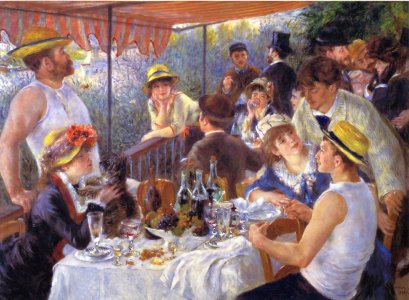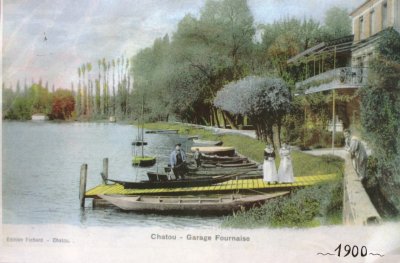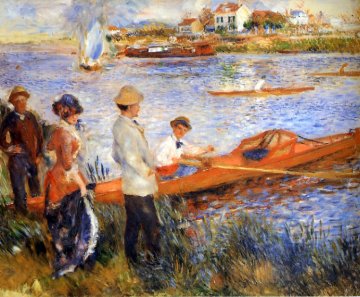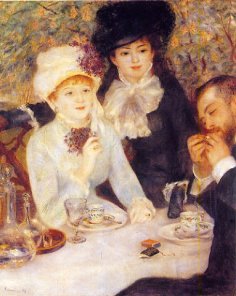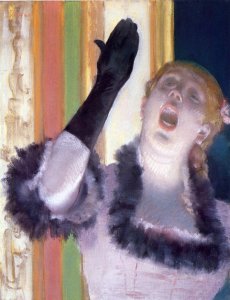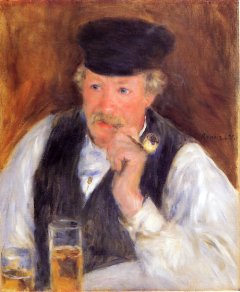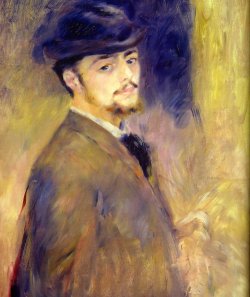
|
Luncheon of the Boating Party
The Painting and the Book
|

|
The figures stroll from Renoir's painting and into the pages of Susan
Vreeland's new novel with all the vibrancy and elegance of the canvas
itself. A marvelous evocation that brings a painting - and an entire age -
beautifully to life.
--Ross King, author of Brunelleschi's Dome; Michelangelo and the Pope's Ceiling; and The Judgment of Paris: The Revolutionary Decade That Gave the World Impressionism.
Luncheon of the Boating Party, the novel and the painting, depicts the summer of 1880,
an exuberant postwar time when social constraints were loosening, Paris was healing, and Parisians
were bursting with a desire for pleasure. The fourteen people on the terrace overlooking the
Seine enjoying this moment of la vie moderne are Renoir's very real friends, my characters,
whose lives unfold and connect during the course of the making of the painting.
|

|

|
Pierre-Auguste Renoir, Déjeuner des Canotiers
(Luncheon of the Boating Party), 1880-81,
The Phillips Collection, Washington, D.C.
|

|

|
The novel's epicenter is the terrace of La Maison Fournaise, a restaurant, small hotel,
and boat rental twenty-minutes by train west of Paris which attracts a mix of Parisians,
especially on Sundays. A popular song of the time extols Sundays when one feels wonderful
and has nothing to do but to enjoy life.
|

|

|
Postcard, circa 1900. Courtesy Betty van Wijhe, 2006
|

|

|
In this spirit, the models go boating in the morning, eat a three-course luncheon, drink aperitifs and
wine and sometimes champagne, get to know one another, and then settle in to their poses. Luckily,
Renoir doesn't mind his models talking, telling stories, even singing, because he wants to catch a
natural moment.
|

|

|
Renoir, Oarsmen at Chatou, 1879
National Gallery of Art, Washington, D.C.
|

|

|
Seven of the models are viewpoint characters who reveal in their own voices the events of
their lives during the weeks in between painting sessions. Their chapters take us into Paris--to
the Ile de la Cité, to Montmartre, to a dance and pleasure garden, backstage at the Comédie-Français
and the Folies-Bergère.
|

|

|
Renoir, End of the Lunch, 1879
Stadelsches Kunstinstitute, Frankfurt
Seated model: Ellen Andree.
|

|

|
Chapters from Renoir's point of view take us to his studio, the Café Nouvelle-Athènes frequented
by artists and writers, his neighborhood crémerie which has its own set of amusing characters,
place Pigalle, a string of Montmartre cabarets, the Tuileries gardens, and, of course, the Louvre.
|

|

|
Edgar Degas, The Glove, 1878
Harvard University Art Museums, Cambridge, MA
|

|

|
Besides the fourteen models, the novel has a rich cast of characters from all social classes--Alphonse
and Louise Fournaise, engaging proprietors of the Maison, Edgar Degas, the writer Guy de Maupassant,
an influential and legendary art dealer, a rich patron, a passionate art supply dealer and his quirky
wife, eight fully-developed characters who have something to do with the painting, and ten more of
lesser importance. Although some chapters appear to take us far afield from the posing, what goes on
in these chapters always impacts the painting, so everything is woven together like a canvas.
|

|

|
Renoir, Monsieur Fournaise, 1875. © 2006
Sterling and Francine Clark Art Institute, Williamstown, MA
|

|

|
Beside the obvious themes of the challenges Renoir faces in this complex painting, the novel
depicts Renoir's personal artistic crisis, the wrenching breakup of the Impressionist group,
and the upheaval and change in the marketing of art. Themes of the yearning for creative
expression, social changes in marriage and in inter-class relationships, and, of course,
love give the novel human scope. Among the models and the ancillary characters, there are
three love triangles, each of which has its moments of action and of reflection, of ebbing and
flowing. Through it all, there is the eternal Seine, an ever-changing backdrop, city and country,
a gentle influence on the characters, and thus on the painting.
|

|

|
Renoir, Self-Portrait, 1876
Fogg Art Museum, Cambridge, MA
|

|
|
